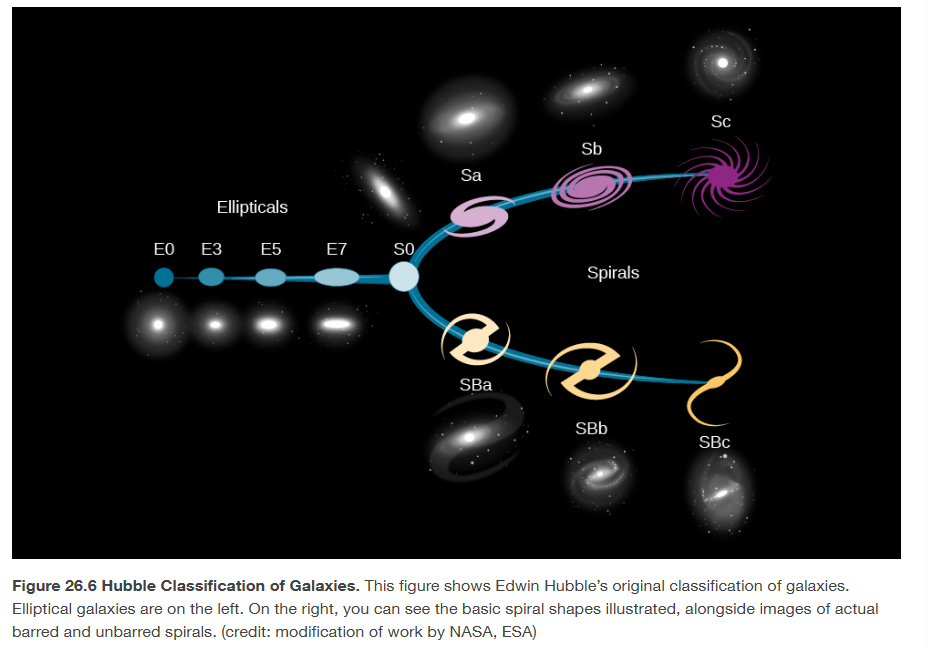26.2 types of galaxies & 26.3 properties of galaxies & 26.4 the extragalactic distance scale & 26.5 expanding universe
1/10
There's no tags or description
Looks like no tags are added yet.
Name | Mastery | Learn | Test | Matching | Spaced |
|---|
No study sessions yet.
11 Terms
spiral galaxies
consist of a central bulge, a halo, a disk, and spiral arms
bright emission nebulae and hot, young stars are present, especially in the spiral arms
new star formation occurring
disks are often dusty
contain a mixture of young and old stars
all spiral rotate
about 2/3 of nearby spiral galaxies have boxy or peanut-shaped bars of stars running through their centers
these galaxies are called barred spirals
spirals usually begin from the ends of the bar
luminous parts appear to range in diameter from about 20,000 to more than 100,000 light years
masses of visible portions, 1 billion-1 trillion Suns
luminosity; 100 million - 100 billion times the luminosity of our Sun
classification of galaxies

elliptical galaxies
consist almost entirely of old stars and have shapes that are spheres or ellipsoids (squashed spheres)
not trace of spiral arms
light dominated by older reddish stars (population II)
globular clusters present
contain small amount of interstellar matter
show varying degree of flattening
mass; can be as large as 10^13 Msun
diameters; extend over several 100,000 light years
orbits of stars within the galaxies are not in the same direction
elliptical galaxies don’t appear to rotate in the same systematic way as spiral galaxies
dwarf elliptical galaxies
very faint and difficult to see
luminosity is about equal to the brightest globular clusters
irregular galaxies
galaxies that do not have the regular shapes and do not fit into the main categories
lower masses and luminosities than spiral galaxies
appear disorganised, many are undergoing relatively intense star formation activity
contain population I and II stars
e.g. Large Magellanic Cloud and Small Magellanic Cloud
spiral galaxy mass measurements
use of doppler effect and radial velocity to determine mass
can measure the rotational speed of the galaxy by obtaining spectra of the gas or stars, and looking for wavelength shifts produced by the Doppler effect
elliptical galaxy mass measurements
measure the various speeds with which the stars are moving in their orbits around the center of the galaxy, so we can calculate how much mass the galaxy must contain in order to hold the stars within it
the amount by which each spectra line broadens indicates the range of speeds at which the stars are moving with respect to the galaxy
mass-to-light ratio
ratio of a galaxy’s mass (in units of the Sun’s mass) to its light output (in units of the Sun’s luminosity)
Sun’s mass:light is 1
tells us roughly what kind of stars make up the most luminous population of the galaxy, and also tells us whether a lot of dark matter is present
mass:light is greater than 1 for low-mass stars
galaxies in which star formation is still occuring have many massive stars, and thier mass:light is usually 1-10
galaxies that have an older stellar population (ellipticals) mass:light ratios of 10-20
Sagittarius A*
cosmic radio source in the nucleus of the Galaxy
supermassive black whole
thousands of old, reddish main-sequence stars within a few hundred light years
about 100 OB stars that are newly formed
type Ia supernova
involve the explosion of a white dwarf in a binary system
all have the same luminosity (about 4.5 × 10^9 Lsun)
expanding universe
discovered that the more distant the galaxy, the faster it was receding from us
recession velocities are proportional to distances from us
Hubble’s law: v = H x d
H is Hubble’s constant
uniformly expanding universe
stretching of the universe is what moves things away from us
expansion of space
as space stretches, the galaxies are carried farther and farther apart